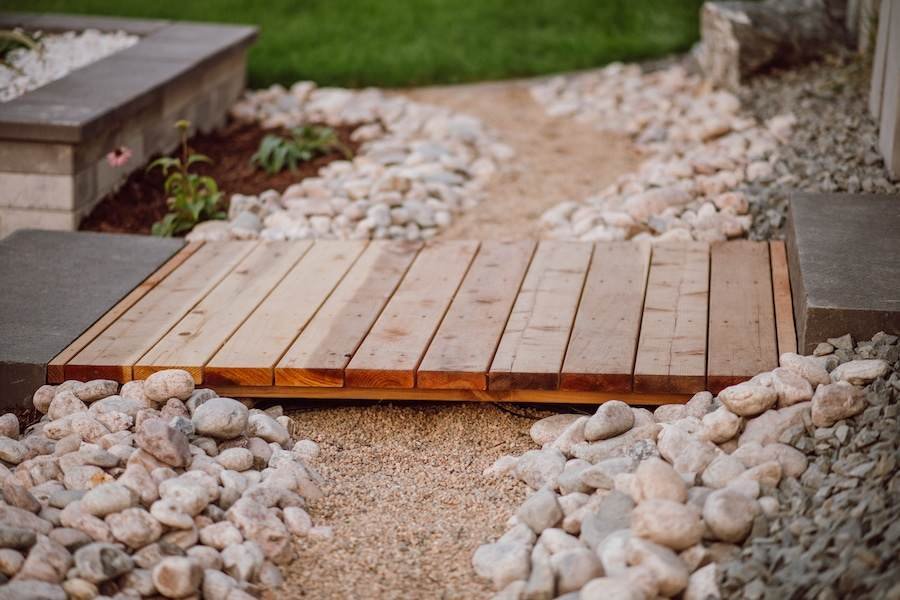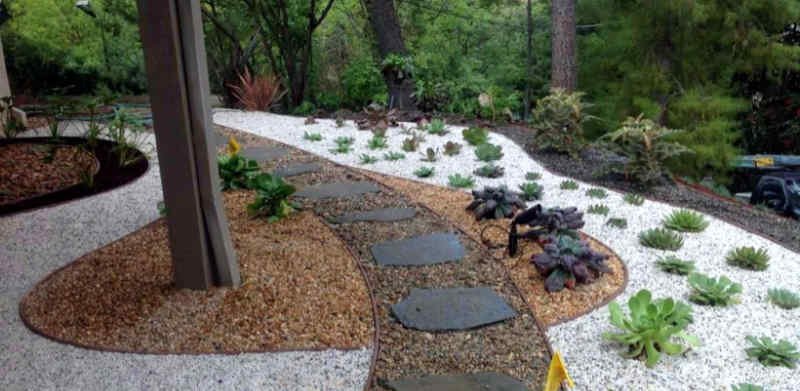Decorative gravel is a popular landscaping material known for its versatility and aesthetic appeal. It comes in various colors, shapes, and sizes, making it a great choice for adding texture and visual interest to gardens, pathways, and driveways. Beyond its looks, it’s also practical, helping with drainage and reducing the need for frequent maintenance. Whether you’re looking to create a stylish walkway or add a finishing touch to your garden, decorative gravel can do it all. If you’re in need of expert landscaping services, Hoskins Landscaping Contractors LLC can help you incorporate gravel into your outdoor space seamlessly.
What is Decorative Gravel?

Decorative gravel is a versatile landscaping material made up of small stones or pebbles, chosen for its aesthetic appeal and functionality. It is used to enhance outdoor spaces, such as creating pathways, driveways, garden beds, and water features. With various colors and textures, decorative gravel can complement any design style. Decorative gravel services include gravel installation, maintenance, and design consultation, helping homeowners create beautiful, low-maintenance landscapes that offer excellent drainage and durability.
Decorative gravel can be made from a variety of stones, such as:
Crushed stone: Typically angular and sharp-edged, which helps the gravel lock together, providing better stability and a solid base.
River rock or smooth pebbles: Rounded stones with a smooth texture, often used for decorative purposes in areas where a softer, more natural look is desired.
Pea gravel: Small, round stones that are smooth to the touch and provide a soft, almost sandy texture. This type of gravel is particularly popular for walkways and playgrounds.
The size of the gravel can also vary, from fine grains that are perfect for filling gaps to larger pieces for adding texture to your landscaping.
Why is Decorative Gravel Used in Landscaping?
There are numerous reasons why decorative gravel has become a staple in landscaping projects. Here are some of the main reasons:
1. Aesthetic Appeal
Decorative gravel adds instant visual interest to any outdoor space. With so many colors, shapes, and sizes available, it can enhance the beauty of your garden, driveway, or backyard design. Whether you’re aiming for a modern, minimalist look or a more natural, rustic aesthetic, decorative gravel can be tailored to suit your vision. Its ability to reflect light adds a dynamic aspect to the design, with the color and texture changing depending on the angle of the sunlight.
For example, if you want to add a pop of color to a dull garden, you might choose brightly colored stones or even mix different shades of gravel for a multi-tonal effect. Alternatively, if you prefer a more neutral look, you could go with earthy tones like browns, grays, or whites that blend seamlessly with other landscape elements such as plants, trees, and water features.
2. Low Maintenance
One of the most significant advantages of using decorative gravel in landscaping is its low-maintenance nature. Unlike grass or plants, which require regular watering, pruning, and fertilizing, gravel is incredibly easy to maintain. Once laid down, gravel doesn’t need much care aside from occasional raking to maintain its appearance and replenish any areas where it may have been disturbed.
Additionally, gravel can help to prevent weed growth in your garden. By acting as a natural weed barrier, gravel limits the amount of sunlight that reaches weed seeds, thus reducing the chances of unwanted plants sprouting up.
3. Effective Drainage
Effective drainage is essential for preventing water buildup, erosion, and damage to your landscape. Decorative gravel is ideal for improving drainage in areas like driveways, pathways, and garden beds, allowing water to flow through and preventing pooling. To ensure optimal drainage, proper grading is key to directing water away from structures and preventing foundation damage. Grading and drainage services can assess your landscape, design a drainage plan, and implement solutions like French drains or gravel installation to protect your property from water-related issues.
Decorative gravel is an excellent solution for areas where drainage is a concern. Whether you’re working with a garden bed, a pathway, or a driveway, gravel’s porous nature allows rainwater to flow through it, preventing pooling and runoff. This is especially useful in areas that tend to become waterlogged or where excess moisture could damage plants or create muddy surfaces.
Using gravel in areas prone to heavy rainfall can help manage water flow and ensure that your landscaping remains dry and usable. For instance, if you have a sloped garden or a driveway with poor drainage, laying down gravel can help water pass through, preventing erosion and flooding.
4. Versatility in Design
Gravel can be used in a wide range of landscaping designs, from large-scale projects like driveways to smaller areas like garden borders or decorative features. It’s highly versatile, offering flexibility in terms of how it’s applied and where it can be used. For example, decorative gravel is often used in:
Pathways: Gravel is ideal for walkways, providing a comfortable surface to walk on that is both practical and aesthetically pleasing.
Driveways: Gravel driveways are not only cost-effective but also offer a rustic, natural look that blends well with the surrounding landscape.
Garden Beds: Gravel can be used as a ground cover for flower beds or vegetable gardens, offering a clean and tidy look while helping to retain moisture and control weeds.
Patios: A gravel patio can create a cozy outdoor living space with a relaxed vibe, perfect for casual gatherings or as a focal point in your backyard.
Water Features: Decorative gravel can be used around fountains, ponds, and other water features, adding texture and creating a more natural-looking environment.
With its variety of types, sizes, and colors, gravel can be customized to suit almost any part of your landscaping project.
5. Cost-Effective
Compared to other landscaping materials like pavers, stone tiles, or grass, decorative gravel is an affordable choice for homeowners. The cost of gravel is typically much lower than other hardscaping materials, making it a great option for those on a budget or looking to stretch their landscaping dollar.
Additionally, gravel is a long-lasting material, which means that once you’ve laid it down, it won’t need to be replaced for many years. This makes it a cost-effective solution for large areas or high-traffic spots like driveways and walkways.
How to Incorporate Decorative Gravel into Your Landscaping

Incorporating decorative gravel into your landscaping can enhance the look of pathways, driveways, garden beds, or patios by adding texture and color. It also helps with drainage and weed control. To get the best results, use gravel to create defined areas or as a base for other landscaping features like water fountains or sculptures. Landscaping services can assist with selecting the right gravel, proper installation, and ongoing maintenance, ensuring your outdoor space remains functional, beautiful, and low-maintenance for years.
Now that we’ve covered the main reasons for using decorative gravel in landscaping, let’s look at some ways you can incorporate it into your own outdoor projects. Here are a few ideas:
1. Create a Gravel Pathway
Gravel is the perfect material for creating a natural, rustic-looking pathway. Whether it’s a winding trail through your garden or a straight walkway to your front door, gravel adds charm and texture to any path. To make the pathway more defined, you can use edging materials like bricks, wood, or metal to create a clean boundary between the gravel and surrounding plants.
2. Design a Gravel Garden Bed
Gravel is an excellent option for garden beds, providing a neat, clean appearance while allowing for proper drainage. To create a gravel garden bed, start by laying down landscaping fabric to prevent weeds from growing, then cover the fabric with a layer of gravel. This type of garden bed requires less maintenance and can help highlight the plants and flowers in your garden.
3. Enhance Your Driveway
A gravel driveway offers a unique and low-maintenance alternative to traditional paved driveways. The key to creating a functional gravel driveway is to ensure that the gravel is laid down on a solid base, such as a crushed stone sub-base, to prevent shifting or uneven surfaces. You can also choose from a variety of gravel colors to match your home’s exterior or overall landscape design.
4. Install a Gravel Patio
For a more informal outdoor living space, consider installing a gravel patio. This type of patio can be customized with different types of gravel to suit your aesthetic. You can also add other features like outdoor furniture, fire pits, or water features to make your patio a relaxing retreat.
FAQs
What are the benefits of decorative gravel?
Decorative gravel enhances the aesthetic appeal of outdoor spaces with its wide range of colors, textures, and sizes, adding visual interest and style. It offers practical benefits, such as excellent drainage and low maintenance, reducing the need for frequent upkeep. Additionally, gravel helps prevent weed growth and soil erosion, making it a sustainable and eco-friendly landscaping choice.
How do you use decorative gravel?
Decorative gravel can be used to create pathways, driveways, or garden borders, adding texture and visual appeal to outdoor spaces. It’s ideal for filling garden beds, helping with drainage while preventing weed growth. Gravel can also be used around water features, like ponds or fountains, to enhance the natural look and provide a stable, low-maintenance surface.
What is gravel and what is it used for?
Gravel is a loose aggregate made up of small, rounded stones or crushed rock, typically used in construction and landscaping. It is commonly used for creating driveways, pathways, and drainage systems due to its durability and ability to allow water to pass through. Gravel is also used as a base material for paving, concrete, and in various landscaping applications for aesthetic purposes.
What are the uses of decorative stone?
Decorative stone is often used in landscaping to add visual appeal, such as creating garden borders, pathways, or rock gardens. It can also be applied around water features, like ponds or fountains, to enhance their natural aesthetic. Additionally, decorative stone is used in driveways, patios, and outdoor seating areas to provide a durable, low-maintenance surface with a unique design.
What is a decorative stone?
A decorative stone is a type of stone used primarily for aesthetic purposes in landscaping and design. It comes in various shapes, sizes, colors, and textures, making it versatile for adding beauty to outdoor spaces. Decorative stones are commonly used for garden borders, pathways, patios, and water features, providing both functional and visual appeal.
Conclusion
Decorative gravel is a fantastic choice for homeowners looking to enhance the beauty and functionality of their outdoor spaces. With its wide range of colors, textures, and sizes, gravel offers flexibility and creativity in design while being easy to maintain and environmentally friendly. Whether you’re creating a pathway, a garden bed, a driveway, or a patio, decorative gravel can help you achieve the look you want without breaking the bank.
If you’re considering using decorative gravel in your landscaping project, it’s always a good idea to consult with experts like Hoskins Landscaping Contractors LLC, who can provide valuable advice on selecting the right type of gravel, laying it down correctly, and ensuring that it works seamlessly with the rest of your landscape design. With the right approach, decorative gravel can be a beautiful, functional, and sustainable addition to your home’s outdoor space.
